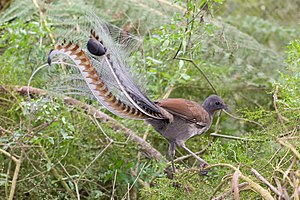Menuridae
| Lyrebird Temporal range: Early Miocene to present |
|
|---|---|
 |
|
| Superb lyrebird | |
| Scientific classification | |
| Kingdom: | Animalia |
| Phylum: | Chordata |
| Class: | Aves |
| Order: | Passeriformes |
| Suborder: | Passeri |
| Family: |
Menuridae Lesson, 1828 |
| Genus: |
Menura Latham, 1801 |
| Species | |
A lyrebird is either of two species of ground-dwelling Australian birds that compose the genus Menura, and the family Menuridae. They are most notable for their superb ability to mimic natural and artificial sounds from their environment, and the striking beauty of the male bird's huge tail when it is fanned out in courtship display. Lyrebirds have unique plumes of neutral-coloured tailfeathers and are among Australia's best-known native birds.
The classification of lyrebirds was the subject of much debate after the first specimens reached European scientists after 1798. The superb lyrebird was first illustrated and described scientifically as Menura superba by Major-General Thomas Davies in 1800 to the Linnean Society of London. He based his work on specimens sent from New South Wales to England.
Lyrebirds were thought to be Galliformes like the broadly similar looking partridge, junglefowl, and pheasants familiar to Europeans, reflected in the early names given to the superb lyrebird, including native pheasant. They were also called peacock-wrens and Australian birds-of-paradise. The idea that they were related to the pheasants was abandoned when the first chicks, which are altricial, were described. They were not classed with the passerines until a paper was published in 1840, 12 years after they were assigned a discrete family, Menuridae. Within that family they compose a single genus, Menura.
It is generally accepted that the lyrebird family is most closely related to the scrub-birds (Atrichornithidae) and some authorities combine both in a single family, but evidence that they are also related to the bowerbirds remains controversial.
Lyrebirds are ancient Australian animals: the Australian Museum has fossils of lyrebirds dating back to about 15 million years ago. The prehistoric Menura tyawanoides has been described from Early Miocene fossils found at the famous Riversleigh site.
...
Wikipedia
